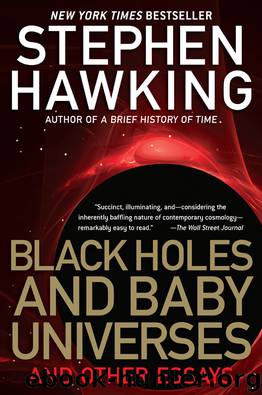Black Holes and Baby Universes and Other Essays

Author:Stephen Hawking [Hawking, Stephen]
Language: eng
Format: epub
ISBN: 978-0-307-79045-3
Publisher: Random House Publishing Group
Published: 2011-05-10T16:00:00+00:00
*A lecture given at the Three Hundred Years of Gravity conference held in Cambridge in June 1987, on the three hundredth anniversary of the publication of Newton’s Principia.
Ten
THE QUANTUM MECHANICS OF BLACK HOLES*
THE FIRST THIRTY years of this century saw the emergence of three theories that radically altered man’s view of physics and of reality itself. Physicists are still trying to explore their implications and to fit them together. The three theories are the special theory of relativity (1905), the general theory of relativity (1915), and the theory of quantum mechanics (c. 1926). Albert Einstein was largely responsible for the first, was entirely responsible for the second, and played a major role in the development of the third. Yet Einstein never accepted quantum mechanics because of its element of chance and uncertainty. His feelings were summed up in his oft-quoted statement “God does not play dice.” Most physicists, however, readily accepted both special relativity and quantum mechanics because they described effects that could be directly observed. General relativity, on the other hand, was largely ignored because it seemed too complicated mathematically, was not testable in the laboratory, and was a purely classical theory that did not seem compatible with quantum mechanics. Thus, general relativity remained in the doldrums for nearly fifty years.
The great extension of astronomical observations that began early in the 1960s brought about a revival of interest in the classical theory of general relativity because it seemed that many of the new phenomena that were being discovered, such as quasars, pulsars, and compact X-ray sources, indicated the existence of very strong gravitational fields—fields that could be described only by general relativity. Quasars are starlike objects that must be many times brighter than entire galaxies if they are as distant as the reddening of their spectra indicates; pulsars are the rapidly blinking remnants of supernova explosions, believed to be ultradense neutron stars; compact X-ray sources, revealed by instruments aboard space vehicles, may also be neutron stars or may be hypothetical objects of still higher density, namely black holes.
One of the problems facing physicists who sought to apply general relativity to these newly discovered or hypothetical objects was to make it compatible with quantum mechanics. Within the past few years there have been developments that give rise to the hope that before too long we shall have a fully consistent quantum theory of gravity, one that will agree with general relativity for macroscopic objects and will, one hopes, be free of the mathematical infinities that have long bedeviled other quantum field theories. These developments have to do with certain recently discovered quantum effects associated with black holes, which provide a remarkable connection between black holes and the laws of thermodynamics.
Let me describe briefly how a black hole might be created. Imagine a star with a mass ten times that of the sun. During most of its lifetime of about a billion years, the star will generate heat at its center by converting hydrogen into helium. The energy released will create
Download
This site does not store any files on its server. We only index and link to content provided by other sites. Please contact the content providers to delete copyright contents if any and email us, we'll remove relevant links or contents immediately.
| Aeronautics & Astronautics | Astronomy |
| Astrophysics & Space Science | Comets, Meteors & Asteroids |
| Cosmology | Mars |
| Solar System | Star-Gazing |
| Telescopes | UFOs |
Turbulence by E. J. Noyes(7069)
Tools of Titans by Timothy Ferriss(6986)
Astrophysics for People in a Hurry by Neil DeGrasse Tyson(4634)
Room 212 by Kate Stewart(4126)
Pale Blue Dot by Carl Sagan(4027)
The David Icke Guide to the Global Conspiracy (and how to end it) by David Icke(3902)
Secrets of Antigravity Propulsion: Tesla, UFOs, and Classified Aerospace Technology by Ph.D. Paul A. Laviolette(3647)
A Journey Through Divination and Astronomy by Publishing Pottermore(3219)
Apollo 8 by Jeffrey Kluger(3210)
Losing the Nobel Prize by Brian Keating(3191)
Goodbye Paradise(2989)
COSMOS by Carl Sagan(2966)
How to Read Water: Clues and Patterns from Puddles to the Sea (Natural Navigation) by Tristan Gooley(2891)
Brief Answers to the Big Questions by Stephen Hawking(2886)
The Five People You Meet in Heaven by Mitch Albom(2855)
The Order of Time by Carlo Rovelli(2748)
How to Read Nature by Tristan Gooley(2673)
A Brief History of Time by Stephen Hawking(2487)
Aliens by Jim Al-Khalili(2392)
